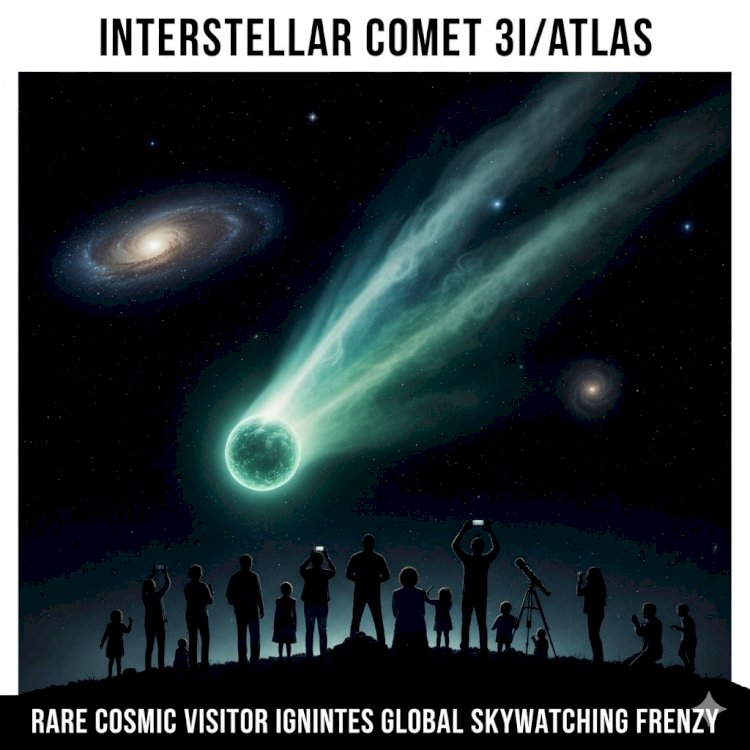Interstellar Comet 3I/ATLAS Streaks Toward Sun: Rare Cosmic Visitor Ignites Global Skywatching Frenzy

Ancient Traveler from Another Star System Nears Perihelion, Sparking Wonder and Science
Washington, D.C., October 29, 2025 – As the veil of night drapes over observatories from Hawaii to the Canary Islands, the cosmos delivers a guest unlike any other: Comet 3I/ATLAS, the third confirmed interstellar wanderer to grace our solar system, hurtles toward its closest embrace with the Sun today. Discovered just four months ago, this icy relic from a distant stellar nursery—potentially billions of years old—promises astronomers a fleeting window into the universe's hidden archives, while igniting imaginations with whispers of extraterrestrial origins.
Dubbed 3I/ATLAS after the telescope network that first spied it on July 1, the comet follows a hyperbolic path that screams "outsider." Unlike the predictable ellipses of homegrown comets, its trajectory betrays a speed of 60 kilometers per second relative to the Sun, flinging it from the void between stars into our cosmic backyard before an inevitable exit stage left. At roughly 20 kilometers wide, with a teardrop-shaped dust cocoon enveloping its nucleus, 3I/ATLAS is no mere speck—it's a time capsule, forged in the primordial fires of another solar system.
A Fleeting Solar Rendezvous
Perihelion arrives at approximately 1.4 astronomical units (AU) from the Sun—just inside Mars' orbit—unfolding in solar conjunction, where the comet hides behind our star's glare from Earth's vantage. This cosmic game of hide-and-seek means ground-based telescopes are momentarily blind, but spaceborne sentinels stand ready. NASA's Mars orbiters, including the veteran Mars Reconnaissance Orbiter, pivot their instruments toward the intruder, capturing spectra of its outgassing jets—streams of carbon dioxide and exotic ices that hint at alien chemistry.
Hubble's July snapshot, taken when the comet was 277 million miles away, revealed a nucleus shrouded in a 26,000-kilometer-wide coma, twice Earth's diameter, laced with unfamiliar dust grains. "This isn't just a comet; it's a messenger," marveled Dr. Elena Vasquez, lead investigator at NASA's Goddard Space Flight Center. "Its composition—rich in heavy elements from an older stellar disk—could rewrite what we know about planet formation elsewhere."
The European Space Agency's Juice probe, en route to Jupiter's moons, may even dip into the comet's ion tail next month, sampling charged particles like a cosmic net. Meanwhile, amateur astronomers worldwide calibrate backyard scopes, knowing the object reemerges in December for its closest Earth approach at 1.8 AU—about 170 million miles, safely distant but tantalizingly observable with an 8-inch telescope under dark skies.
Echoes of 'Oumuamua and Borisov: A Third Act in Interstellar Drama
3I/ATLAS joins an elite trio of interstellar interlopers. The enigmatic cigar-shaped 'Oumuamua in 2017 sparked alien probe theories with its non-gravitational acceleration; Borisov in 2019 behaved more like a familiar comet, sporting a gaseous tail. This newcomer blends the two: active outgassing like Borisov, but with a velocity profile suggesting origins in the Milky Way's thick disk—a region of ancient, metal-poor stars predating our Sun by billions of years.
Harvard astrophysicist Avi Loeb, who championed 'Oumuamua as potential tech, tempers speculation here. "While 3I/ATLAS shows no anomalous propulsion, its age—estimated at 7.6 to 14 billion years—challenges models of comet longevity. It may have slingshotted through countless systems before us." Online, the comet fuels fringe fervor: Nostradamus quatrains twist into doomsday verses, and Baba Vanga's vague 2025 portents of "celestial fire" trend on social feeds. NASA, ever the voice of reason, debunks collision fears outright: "No threat—it's farther than the average asteroid belt."
Planetary Defense in the Stars
Beyond wonder, 3I/ATLAS serves a pragmatic purpose. NASA's Planetary Defense Coordination Office orchestrates a global observation campaign, honing astrometry—the precise tracking of celestial paths—to better predict hazardous near-Earth objects. "Interstellar visits are rare rehearsals for the real threats," noted agency director Lindley Johnson. Small telescopes worldwide contribute data, turning citizen scientists into sentinels.
As the comet slaloms past Mars—having buzzed the Red Planet on October 3—its passage stirs broader reflections. In an era of exoplanet discoveries, 3I/ATLAS embodies the galaxy's connectivity: a frozen echo from worlds we'll never tread, reminding us that our solar system is but a brief layover on the interstellar highway.
Eyes to the Sky: A Call to Gazers
For skywatchers, the comet's December return offers prime viewing in the constellation Virgo, peaking at magnitude 12—faint but feasible for enthusiasts. Apps like Stellarium plot its arc, while virtual planetariums simulate the show. "Grab binoculars and find dark skies," urges the International Astronomical Union. "This is history—our third interstellar handshake."
As 3I/ATLAS crests toward the Sun's fire, humanity pauses, telescopes trained on the infinite. In its icy heart lies not just science, but a profound poetry: proof that even in the vast cold, connections span the stars. By January 2026, it will fade into the outer darkness, bound for another system's dawn. But the secrets it whispers? Those endure, etching our place in a universe alive with wanderers.

 content-team
content-team 

















